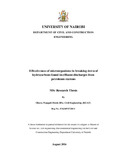| dc.contributor.author | Okova, Derek | |
| dc.date.accessioned | 2016-12-22T09:50:52Z | |
| dc.date.available | 2016-12-22T09:50:52Z | |
| dc.date.issued | 2016 | |
| dc.identifier.uri | http://hdl.handle.net/11295/98287 | |
| dc.description.abstract | The study aimed at establishing the potential of using aerobic microbial degradation to treat and reduce volume of hydrocarbon in effluent discharges from petrol stations wastes. Microbial degradation of hydrocarbons (HC) has been considered the most promising technology and it is natural, less toxic and relatively cost-effective having been used to clean oil spills in rivers, oceans and in tank farms.
The objectives were realised through subjecting two different samples of 1.5 litres each from different service stations interceptors to physiochemical laboratory tests, chromatography analysis and a heterotrophic bacteria count. The samples were further split into two so that one sample remained as collected from site while the other one had nitrates and phosphates (N/P) added to it. The tests were to establish the changes in the physiochemical parameters, to confirm the changes that took place by characterising the samples and lastly to study the behaviour and growth of the bacteria over 40 days respectively. Addition of nitrates and phosphates was to confirm the impact of nutrients on the HC breakdown as well as bacterial growth.
The changes in the physiochemical parameters (COD, TDS, Nitrates and Phosphates) showed reduction in hydrocarbons. COD tests were critical to establish reduction of hydrocarbons (organic compounds) as COD quantities reduced by 35% and 30% in the TPS and Oilibya Samples with N/P respectively. The chromatography analysis also showed quantities of the various hydrocarbons that constituted the effluent reducing over time and in some cases completely eliminated. Addition of N/P saw faster growth of the microorganism population i.e. by 284% in the Oilibya Sample with N/P as compared to 5.8% in sample without N/P and 307% in the TPS sample with N/P compared to 8.5% in sample without. The study recommends a further study on identification of the responsible HC utilizing bacteria and use of the same on site in the interceptors. | en_US |
| dc.language.iso | en | en_US |
| dc.publisher | University of Nairobi | en_US |
| dc.rights | Attribution-NonCommercial-NoDerivs 3.0 United States | * |
| dc.rights.uri | http://creativecommons.org/licenses/by-nc-nd/3.0/us/ | * |
| dc.subject | Effluent Discharges From Petroleum Stations | en_US |
| dc.title | Effectiveness of Microorganisms in Breaking Down of Hydrocarbons Found in Effluent Discharges From Petroleum Stations | en_US |
| dc.type | Thesis | en_US |



